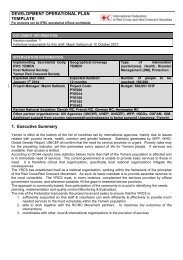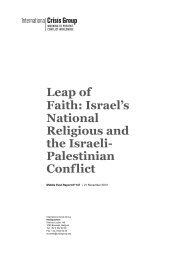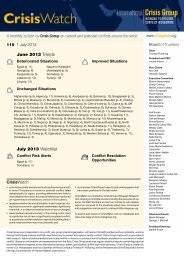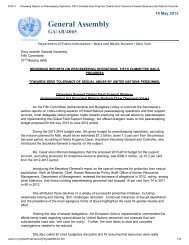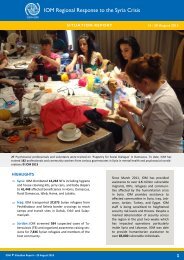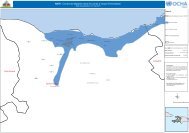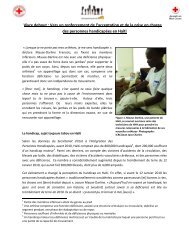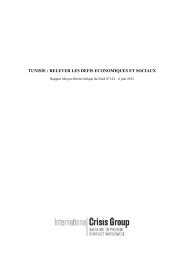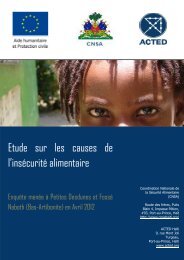SOMALI NUTRITION STRATEGY 2011 – 2013 - ReliefWeb
SOMALI NUTRITION STRATEGY 2011 – 2013 - ReliefWeb
SOMALI NUTRITION STRATEGY 2011 – 2013 - ReliefWeb
You also want an ePaper? Increase the reach of your titles
YUMPU automatically turns print PDFs into web optimized ePapers that Google loves.
4<br />
Preliminary results of the meta-analysis<br />
also highlight how the situation has been<br />
consistently worse in South Central<br />
Somalia than Puntland or Somaliland.<br />
In South Central Somalia, median rates<br />
of stunting were found to be 29.7% and<br />
wasting 18%; this compares to 20%<br />
stunting and 17% wasting for Puntland<br />
and 18% stunting and 13% wasting for<br />
Somaliland (see figure 3). This reflects<br />
the devastating effect of chronic political<br />
conflict and insecurity in South Central<br />
Somalia in particular.<br />
Rates of malnutrition also vary according<br />
to livelihood system. Briefly, preliminary<br />
results of the FSNAU meta analysis of<br />
data 2001-2008 revealed that riverine<br />
and agro-pastoralist groups had the<br />
highest median rate of wasting, stunting<br />
and underweight suggesting a higher<br />
nutritional vulnerability to shocks <strong>–</strong> floods,<br />
drought, displacement, disease outbreak.<br />
Rates of malnutrition among the urban<br />
population tended to be lower, reflecting<br />
better access to a diversified diet and to<br />
public services including health.<br />
The recent National Micronutrient<br />
and Anthropometric Nutrition survey<br />
conducted between March and August<br />
2009 in all three zones, has highlighted<br />
micronutrient malnutrition is a significant<br />
public health problem throughout Somalia.<br />
The prevalence of both nutritional<br />
anaemia and vitamin A deficiency among<br />
women and children of all age groups<br />
was found to be above WHO thresholds<br />
for classifying a severe situation in each<br />
of the 3 zones (see figure 4).<br />
Figure 2: Annual National Median Stunting rates 2001-2009<br />
stunting rate %<br />
Figure 3: Malnutrition rates by Zone in Somalia (2001-2008)<br />
prevalence %<br />
Median proportion (%)<br />
40%<br />
35%<br />
30%<br />
25%<br />
20%<br />
15%<br />
10%<br />
5%<br />
0%<br />
100<br />
90<br />
80<br />
70<br />
60<br />
50<br />
40<br />
30<br />
20<br />
10<br />
0<br />
35<br />
30<br />
25<br />
20<br />
15<br />
10<br />
5<br />
0<br />
2001 2002 2003 2004 2005 2006 2007 2008 2009<br />
Year<br />
13.3<br />
NW NE SC<br />
15.8<br />
18.2<br />
16.85<br />
20.0<br />
29.65<br />
14.15<br />
Wasting Stunting Underweight<br />
Anaemia<br />
Source: FSNAU 2010<br />
19.0<br />
26.7<br />
Source FSNAU data<br />
Figure 4: Prevalence of anaemia and vitamin A deficiency<br />
amongst children and women<br />
6-59mths school aged children pregnant women non-pregnant women all women<br />
Vit A deficiency<br />
Source FSNAU data Micronutrient Study<br />
1.2 Determinants of malnutrition<br />
Malnutrition results from a complex set of factors and not one simple cause. The UNICEF conceptual<br />
model of causes of malnutrition (page 16) provides a useful framework for the discussion of the<br />
causes of malnutrition in Somalia. The volatile political situation and civil unrest have led to a<br />
chronic and continuing humanitarian crisis that is at the root of the high prevalence of malnutrition<br />
in Somalia. Somalia is also prone to drought and floods. Many of the environmental and man<br />
made shocks have been multiple and recurrent, over stretching families’ coping mechanisms<br />
resulting in inadequate access to and availability of food at household level.




